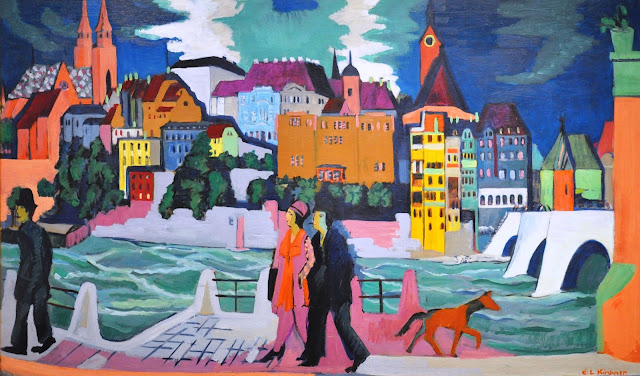I first discovered the paintings of the German Expressionists during a visit to the Milwaukee Art Museum, so I was quite excited when I saw the collection of German Expressionist paintings at the St. Louis Art Museum. I love the bold colors that this group of painters used in creating their works.
Of course, the German Expressionists were at the center of controversy during the early years of the Hitler Regime. Many of the artists' works were deemed degenerate art by Hitler and the paintings (and sometimes the painters themselves) were destroyed by Hitler's order. See my blog post in August, 2010 titled War Booty for more information.
In 1983, businessman and philanthropist Morton D. May (grandson of the founder of the May/Famous Barr Department Store chain) bequeathed his extensive collection of German Expressionist paintings to the St. Louis Art Museum. Morton D. May began collecting German Expressionist paintings in the late 1940s. His first purchase was a painting by Max Beckmann; his collection grew substantially when Mr. May discovered that Max Beckmann was actually living right in St. Louis and teaching at the local Washington University. The two became close friends, and Morton May amassed one of the largest collections of Beckmann's works in the country.
All of the following paintings were part of Morton D. May's amazing collection:
Self-Portrait in Blue Jacket (1950) by Max Beckmann
(His 35th and final self-portrait)
Young Men by the Sea (1943) by Max Beckmann
The Bath (1930) by Max Beckmann
Acrobats (1939) by Max Beckmann
More than a dozen figures—including acrobats, tight-rope walkers, a snake handler
and other characters—bind together the panels of this triptych.
Acrobat on Trapeze (1940) by Max Beckmann
Beckmann's diaries from Amsterdam recount his numerous visits to cabarets,
theaters, and the circus.
Woman in Strong Light (1912) by Emil Nolde
Red Evening Sky (1915) by Emil Nolde (Such brilliant color!)
Sunset (1921) by Max Pechstein
Day of Steel (1911) by Max Pechstein
The Big Indian (1910) by Max Pechstein
Harlequin and Columbine (1913) by Heinrich Campendonk
Bucolic Landscape (1913) by Heinrich Campendonk
I love the bold colors in both of these paintings by Campendonk!
Spring (1912) by Alexei von Jawlensky
The Little Mountain Goats (1913-1914) by Franz Marc
Landscape with Cows, Sailing Boat and Figures (1914) by August Macke
Winter Landscape (1911) by Wassily Kandinsky
Between 1909 and 1911, Kandinsky lived and worked in Murnau, a village in the
Bavarian Alps. During this period, the artist turned away from the direct depiction
of nature in favor of a more abstract approach.
The Painter and His Model II (1923) by Oskar Kokoschka
Circus Rider (1914) by Ernst Ludwig Kirchner
Kirchner is one of my favorite artists. Here are two other paintings by him that were not part of the May bequest:
Portrait of a Woman (1911)
View of Basel and the Rhine (1927-1928)
In 1905, Ernst Ludwig Kirchner was one of the founding members of the art movement Die Brücke (The Bridge). In 1906, Max Pechstein and Emil Nolde joined the group. The Brücke style attempted the creation of pure expression through color and form. Their aim was to find new ways of artistic expression and to free themselves from the traditional academic style of the time. The Brücke is therefore one of the earliest German artists’ associations which had a crucial impact on the development of classical modern art. The artists collectively created a style which was to be defined within 20th century art history as Expressionism.
In 1911, Wassily Kandinsky, Heinrich Campendonk, Alexei Jawlensky, August Macke and Franz Marc later helped form Der Blaue Reiter (The Blue Rider) group. They all shared an interest in abstracted forms and prismatic colors, which, they felt, had spiritual values that could counteract the corruption and materialism of their age. The name Blaue Reiter refers to a key motif in Kandinsky’s work: the horse and rider, which was for him a symbol for moving beyond realistic representation. Der Blaue Reiter dissolved with the outbreak of World War I in August 1914. Kandinsky, a Russian citizen, was forced to return to his homeland; Jawlensky, also Russian, moved to Switzerland and both Marc and Macke, were killed in action.



















